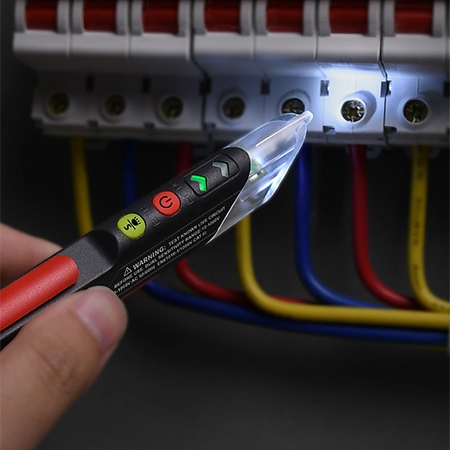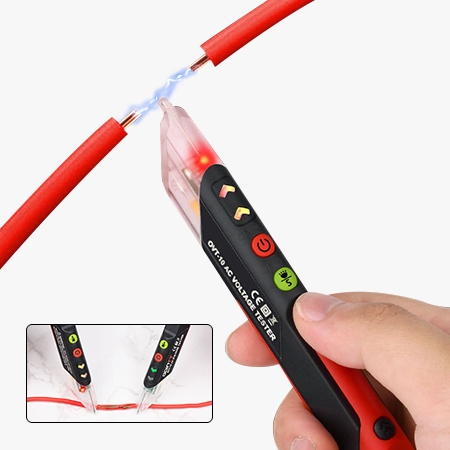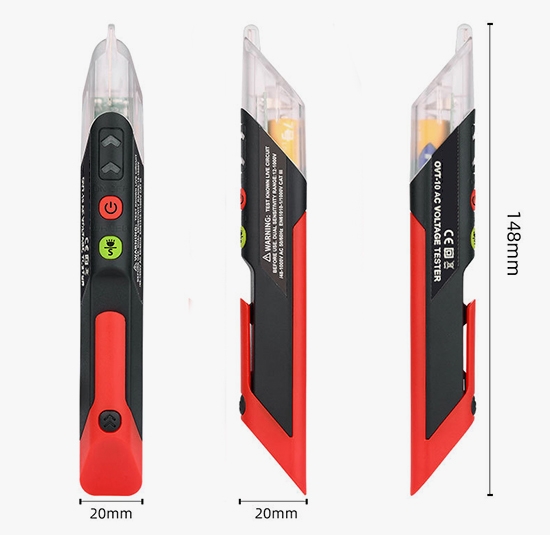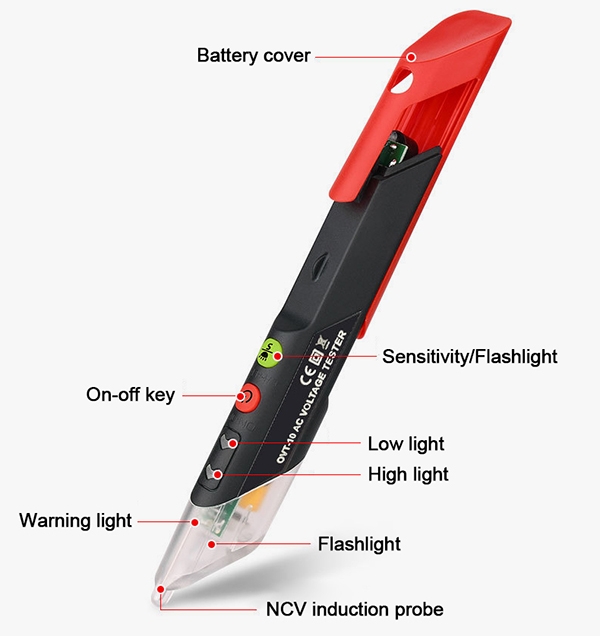The AC voltage detector has a dual range to detect high and low voltage (12-1000V AC/48-1000V AC) for more sensitive and flexible measurements. The dual range voltage tester can be used in circuit breakers, lighting fixtures, switches, outlets, wires and anywhere you need it.

The AC voltage tester design with a LED flashlight lighting
- LED flashlights enhance visibility in dark or low-light environments, making it easier to see the voltage tester's readings or indicators.
- Using an LED flashlight helps accurately locate wires, outlets, or switches, ensuring the voltage tester’s probes are properly aligned with the test points.
- Adequate lighting speeds up the process and makes testing more efficient in dimly lit environments.

Breakpoint finder function
- Voltage detectors are ideal for quickly identifying breaks or faults in electrical circuits, helping to locate the exact point of failure.
- By testing different points along a circuit, a voltage tester helps you systematically isolate and identify where the break or fault is occurring.
- Voltage tester pens help ensure that you are only working on de-energized sections of the circuit during repair, minimizing the risk of electric shock while identifying circuit breaks.
Dimension

Applications
SISCO voltage testers are essential tools used in electrical work to determine the presence and level of electrical voltage in circuits and devices. They help ensure safety by allowing electricians and DIY enthusiasts to verify that circuits are de-energized before performing maintenance or installations. Common applications include residential and commercial electrical work, industrial settings, automotive industry, telecommunications, HVAC systems, utilities and power distribution, and renewable energy systems, where they check outlets, wiring, machinery, vehicle electrical systems, communication equipment, HVAC units, power lines, and renewable energy installations for proper voltage and functionality.

Automotive Industry

Telecommunications

HVAC Systems

Commercial Electrical Work
| Model | SISCO-VT-OVT-10 |
| Measuring Voltage | High sensitivity: AC12-1000V; Low sensitivity: AC48-1000V |
| Display | LED indication |
| Frequency | 50/60 Hz |
| Alarm mode | Sound and light alarm |
| Probe shape | Long flat shape |
| Neutral and live wire judgment | According to the signal strength indication, the live wire is stronger than the neutral wire |
| Signal Strength Display | LED three-level sensitivity |
| Signal Strength Indication Method | The buzzer sound changes from slow to fast, and the LED light changes from orange to red |
| Automatic shutdown | No button operation, automatic shutdown after about 5 minutes without induction signal |
| Flashlight | √ |
| Battery low voltage indication | √ |
| Safety level | EN61010-1, -2-030, EN61326-1, CAT Ⅲ 1000V |
| Dimensions | 148*20*20mm |
| Weight | 50g |
Detail

Q1: What is a voltage tester?
A1: A voltage tester is a tool used to determine the presence and level of electrical voltage in a circuit or device. It helps to ensure safety by allowing users to verify if circuits are live (energized) or de-energized before performing electrical work.
Q2: What are the types of voltage testers?
A2: There are various types of voltage testers, including:
- Non-Contact Voltage Testers (NCVT): Detect voltage by sensing the electric field around a live conductor without making physical contact with it. They usually indicate the presence of voltage through a light, sound, or vibration.
- Contact Voltage Testers: Require direct contact with the conductor to measure voltage. They typically have probes or leads that need to touch the wires or terminals being tested.
- Analog Voltage Testers: Use a needle gauge to show voltage levels. These are less common today but still used in some applications.
Q3: What is the importance of the sampling rate in an AWG?
A3: If your voltage tester isn't detecting voltage, check the following:
- Battery: Replace it if it’s dead.
- Settings: Ensure it’s set to the correct mode and range.
- Tester Condition: Test it on a known live circuit to verify if it’s working.
- Use: Make sure you’re using it correctly and making good contact.
- Power: Verify that the circuit is actually live and turned on.
Tips: How to use a non-contact voltage tester (NCVT)?
Using a non-contact voltage tester (NCVT) is straightforward. Here’s a step-by-step guide:
- Turn On the Tester: Power on the NCVT by pressing the power button. Some models may automatically turn on when the tip is near a live wire.
- Test the Tester: Before using, test the NCVT on a known live circuit (like a working outlet) to ensure it’s functioning properly. The tester should light up or make a sound if it detects voltage.
- Approach the Wire or Outlet: Hold the NCVT near the wire, outlet, or device you want to test. The tip should be close to the surface, but no physical contact is needed.
- Observe the Indicator: If the tester detects voltage, it will emit a light, sound, or vibration, depending on the model. This indicates that the circuit or wire is live.
- Move Along the Wire: For tracing or identifying breaks, move the NCVT along the wire. The indicator will stop when you pass the break point in the circuit.
- Turn Off the Tester: After use, turn off the NCVT to preserve battery life. Some models have an auto-off feature.
Thank you for buying industrial test and measurement equipment on SISCO.com, all products sold by SISCO and the partner cover a 12 months warranty, effective from the date of receiving the products.
What is covered?
SISCO is responsible for providing free spare parts, and free technical support to assist the customer to repair the defective products until the problem is solved.
What is not covered?
- Product purchased from anyone other than a SISCO store or a SISCO authorized reseller.
- Expendable parts.
- Routine cleaning or normal cosmetic and mechanical wear.
- Damage from misuse, abuse or neglect.
- Damage from use of parts other than SISCO approved.
- Damage from use outside the product’s usage or storage parameters.
- Damage from use of parts not sold by SISCO.
- Damage from modification or incorporation into other products.
- Damage from repair or replacement of warranted parts by a service provider other than a SISCO authorized service provider.
- Damage caused by the application environment not meeting the product usage requirements and the failure to perform preventive maintenance.

